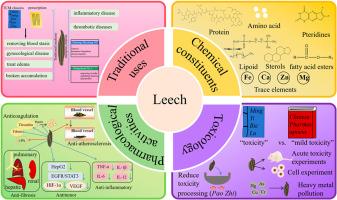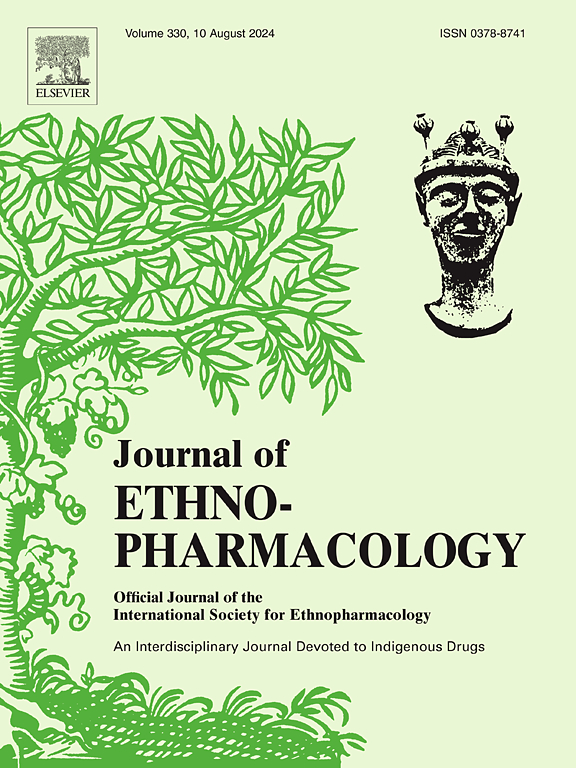水蛭的传统用途、化学成分、药理活性和毒理学研究综述。
IF 5.4
2区 医学
Q1 CHEMISTRY, MEDICINAL
引用次数: 0
摘要
民族药理学相关性:水蛭在亚洲传统医学中被广泛使用,特别是在中国,用于治疗血瘀相关疾病,包括血液病、妇科疾病、创伤、关节炎和水肿。研究目的:对水蛭的传统用途、化学成分、药理活性和毒理学进行系统评价,为水蛭的进一步开发利用提供参考。材料与方法:从多个数据库中获取水蛭的相关资料。此外,还使用中文医学书籍、博士和硕士学位论文来进行这项工作。结果:水蛭的传统用途在中国已经持续了几千年。在过去的几十年里,大约有100种化学成分,包括蛋白质、多肽、氨基酸、脂类、固醇、脂肪酸酯和微量元素,已经从水蛭中鉴定出来。现代药理学研究证实水蛭具有抗凝血、抗血栓、抗动脉粥样硬化、抗纤维化、抗炎等多种生物活性。此外,毒性研究证实了它的安全性。结论:在总结水蛭研究工作的基础上,系统介绍了水蛭的传统用途、化学成分、药理活性和毒理学研究。水蛭是一种著名的传统民族药,其生物活性成分具有许多药理活性,目前正在积极开发传统用途以外的其他用途。现代药理研究主要集中在其对心脑血管系统的作用上。因此,进一步探索其药理活性,填补与其他传统用途和化学成分相关的研究空白具有重要意义。此外,其安全性研究应扩大,为临床应用做准备。本文章由计算机程序翻译,如有差异,请以英文原文为准。

Traditional uses, chemical constituents, pharmacological activities and toxicology of Chinese medicinal leech (Shuizhi): A comprehensive review
Ethnopharmacological relevance
The Chinese medicinal leech (Shuizhi in Chinese) has been widely used in traditional Asian medicine, particularly in China, to treat blood stasis-related disorders, including hematological diseases, gynecological diseases, trauma, arthritis, and edema.
Aim of the study
This review systematically evaluates leech's traditional uses, chemical constituents, pharmacological activities, and toxicology, aiming to provide insights for its further development and utilization.
Material and methods
The relevant information of leech was obtained from several databases. Moreover, the medical books, PhD and MSc dissertations in Chinese were also used to perform this work.
Results
Traditional uses of leech have lasted for millennia in China. Within the past decades, approximately 100 chemical constituents, including proteins, peptides, amino acid, lipids, sterols, fatty acid esters, and trace elements, have been identified from leech. Modern pharmacological studies have confirmed numerous bioactivities of leech, such as anticoagulant activity, antithrombotic activity, antiatherosclerotic activity, anti-fibrotic activity, anti-inflammatory activity. Additionally, toxicity studies confirm its safety.
Conclusion
Based on the summary of the research work of leech, we systematically show the traditional uses, chemical constituents, pharmacological activities and toxicology studies. Leech is a renowned traditional ethnic medicine with numerous pharmacological activities attributed to its bioactive components, and are being actively developed for uses other than traditional uses. Modern pharmacological research primarily focuses on its cardiovascular and cerebrovascular system effect. Therefore, it is important to further explore its pharmacological activities and fill the research gaps related to other traditional uses and chemical constituents. In addition, its safety studies should be expanded to prepare for clinical use.
求助全文
通过发布文献求助,成功后即可免费获取论文全文。
去求助
来源期刊

Journal of ethnopharmacology
医学-全科医学与补充医学
CiteScore
10.30
自引率
5.60%
发文量
967
审稿时长
77 days
期刊介绍:
The Journal of Ethnopharmacology is dedicated to the exchange of information and understandings about people''s use of plants, fungi, animals, microorganisms and minerals and their biological and pharmacological effects based on the principles established through international conventions. Early people confronted with illness and disease, discovered a wealth of useful therapeutic agents in the plant and animal kingdoms. The empirical knowledge of these medicinal substances and their toxic potential was passed on by oral tradition and sometimes recorded in herbals and other texts on materia medica. Many valuable drugs of today (e.g., atropine, ephedrine, tubocurarine, digoxin, reserpine) came into use through the study of indigenous remedies. Chemists continue to use plant-derived drugs (e.g., morphine, taxol, physostigmine, quinidine, emetine) as prototypes in their attempts to develop more effective and less toxic medicinals.
 求助内容:
求助内容: 应助结果提醒方式:
应助结果提醒方式:


